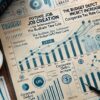
Amidst a global resurgence against the US dollar, the Australian dollar (AUD) found itself lagging behind other major currencies. The lackluster performance came in the aftermath of unexpected labor market contraction data for March, revealing a nuanced economic landscape for Australia.
Surprise Contraction in the Labor Market
The Australian Bureau of Statistics delivered a surprise with its March labor market report, indicating a decline of 6,600 jobs, contrary to the anticipated increase of 7,700. Additionally, the unemployment rate rose to 3.8%, up from the previous 3.7%, defying consensus forecasts. This unexpected setback in employment figures underscores the challenges facing Australia’s economic recovery, raising concerns among policymakers and market participants alike.
Assessment by Economic Experts
Gareth Aird, Head of Australian Economics at Commonwealth Bank of Australia, emphasized the subdued pace of labor market improvement compared to overall economic growth, which remains below trend. Aird and his colleagues foresee further loosening in the labor market over the coming months, potentially prompting the Reserve Bank of Australia (RBA) to consider initiating an easing cycle starting September this year.
RBA’s Monetary Policy Outlook
The Reserve Bank of Australia’s (RBA) monetary policy outlook remains shrouded in uncertainty, with market expectations divided over the timing of potential interest rate adjustments. While overnight index swap rates suggest the likelihood of a cash rate cut in either February or March next year, Blair Chapman, a Senior Economist at ANZ, holds a different view, projecting a 25 basis point rate cut in November.
Divergence in Forecasts
This divergence in forecasts reflects the complexity of Australia’s economic landscape and the RBA’s cautious approach to policy normalization. The uncertainty surrounding Australia’s economic outlook and monetary policy trajectory poses downside risks for the Australian dollar in the near term. As investors navigate through evolving economic data and central bank communications, the AUD may face renewed pressure against its major counterparts.
RBA’s Stance on Interest Rates
Despite mounting economic challenges, the RBA has refrained from providing clear signals regarding the prospect of imminent interest rate cuts. In its March policy statement, the central bank acknowledged the gradual easing of conditions in the labor market but underscored the uncertainty surrounding the path of interest rates needed to ensure inflation returns to target within a reasonable timeframe.
Implications for the Australian Dollar
The RBA’s cautious stance reflects its commitment to supporting economic recovery while closely monitoring inflation dynamics and external risks. Navigating these uncertainties will require a nuanced understanding of Australia’s economic fundamentals and the broader macroeconomic landscape. As policymakers and investors grapple with evolving economic data and policy developments, the AUD’s performance will likely be influenced by a combination of domestic economic factors, global market sentiment, and shifts in risk appetite among investors.
Market Response and Investor Sentiment
The unexpected contraction in Australia’s labor market has prompted a mixed response from investors, leading to increased uncertainty regarding the near-term outlook for the Australian dollar. While some market participants remain cautious, others see potential opportunities amid the evolving economic landscape. The divergence in market sentiment underscores the need for vigilance and adaptability in navigating Australia’s economic recovery trajectory.
Policy Challenges and Economic Resilience
Australia’s policymakers face significant challenges in balancing the need for economic stimulus with the imperative of maintaining price stability and financial resilience. The RBA’s forthcoming policy decisions will play a crucial role in shaping market expectations and investor sentiment. As policymakers strive to navigate these challenges, the Australian dollar is likely to remain sensitive to shifts in economic data, central bank communications, and global market dynamics.
Long-Term Outlook and Structural Reforms
Looking ahead, Australia’s long-term economic outlook will depend on its ability to implement structural reforms aimed at enhancing productivity, fostering innovation, and strengthening resilience to external shocks. While near-term uncertainties persist, Australia’s economic fundamentals remain relatively robust, providing a foundation for long-term growth and stability. By addressing structural challenges and embracing opportunities for innovation and diversification, Australia can position itself for sustainable economic recovery and long-term prosperity.












